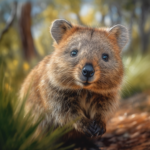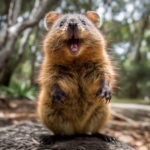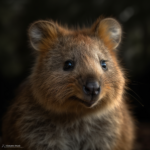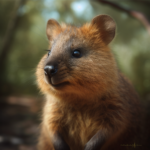The quokka, a small marsupial native to Western Australia, is known for its adorable appearance and friendly demeanor. However, there is a common misconception that quokkas eat their babies. In this article, we will explore this topic and shed light on the truth behind this belief. We will delve into the behavior and diet of quokkas, their reproductive habits, and the reasons why this misconception may have arisen. So, let’s dive in and uncover the fascinating world of quokkas and their offspring.
Key Takeaways
- Quokkas do not eat their babies.
- Quokkas are known for their nurturing behavior towards their young.
- They have a pouch where the babies stay until they are ready to venture out.
- Quokkas are herbivores and mainly feed on plants and grasses.
Understanding Quokkas: The Happiest Animals on Earth

A. Brief Overview of Quokkas
Quokkas are small marsupials native to Western Australia. They are often referred to as the “happiest animals on Earth” due to their friendly and seemingly smiling faces. These adorable creatures belong to the macropod family, which includes kangaroos and wallabies. Quokkas have become quite popular in recent years, attracting tourists from all over the world who want to capture a selfie with these photogenic animals.
Here are some key facts about quokkas:
-
Appearance: Quokkas are about the size of a domestic cat, with a body length of around 50 centimeters (20 inches). They have a stocky build, short legs, and a long tail. Their fur is coarse and usually brown or gray in color.
-
Diet: Quokkas are herbivores, primarily feeding on grasses, leaves, and bark. They have a unique ability to survive on minimal water, obtaining most of their hydration from the vegetation they consume.
-
Habitat: Quokkas are found in a limited range of habitats, mainly in the southwestern region of Western Australia. They prefer dense vegetation, including forests, shrublands, and swamps. One of the most well-known places to spot quokkas is Rottnest Island, located off the coast of Perth.
-
Behavior: Quokkas are primarily nocturnal, meaning they are most active during the night. However, they can also be seen foraging during the day. These social animals live in small family groups and communicate through a variety of vocalizations, including hisses, barks, and clicks.
B. Quokkas’ Habitat and Behavior
Quokkas have adapted to their specific habitat and developed interesting behaviors to ensure their survival. Let’s take a closer look at their habitat preferences and behavioral traits:
-
Rottnest Island: Rottnest Island is home to the largest population of quokkas, making it an ideal place to study their behavior. The island provides a safe haven for these marsupials, as it is free from predators such as foxes and cats. The absence of these threats has allowed the quokka population to thrive.
-
Family Structure: Quokkas have a unique family structure. Females are the primary caregivers and are responsible for raising their young, known as joeys. After a gestation period of about one month, the female gives birth to a tiny, underdeveloped joey, which then crawls into her pouch. The joey remains in the pouch for approximately six months, receiving nourishment and protection.
-
Parenting: Quokka mothers are devoted parents, taking great care of their joeys. They have a strong bond with their young and provide them with milk and warmth in the pouch. Interestingly, quokkas have a specialized muscle in their pouch that allows them to expel the joey if they sense danger or if the joey becomes too large for the pouch.
-
Infanticide Myths: There have been misconceptions about quokkas engaging in infanticide, but scientific studies have debunked these myths. Quokkas are not known to intentionally harm or kill their young. In fact, they exhibit protective behavior towards their joeys and ensure their safety.
Understanding the habitat and behavior of quokkas provides valuable insights into their unique way of life. These fascinating creatures have captured the hearts of many, and their conservation is crucial to preserving the biodiversity of Western Australia. So, if you ever have the opportunity to encounter a quokka, remember to admire them from a respectful distance and appreciate their natural beauty.
Unraveling the Quokka Parenting Myths

A. Do Quokkas Actually Throw Their Babies?
Quokkas, those adorable smiling marsupials found primarily in Western Australia, have gained quite a reputation for their friendly demeanor and photogenic smiles. However, there are several myths surrounding their parenting behavior, one of which is the claim that quokkas throw their babies. But is there any truth to this popular belief?
Contrary to popular belief, quokkas do not actually throw their babies. This misconception likely stems from the fact that quokkas have been observed to expel their young from their pouches. However, this behavior is not an act of aggression or abandonment. Rather, it is a natural part of their reproductive cycle.
B. Why Do Quokkas Throw Their Babies: The Survival Strategy
The expulsion of quokka joeys from their mother’s pouch is a survival strategy employed by these marsupials. Quokkas have a unique reproductive system where they give birth to relatively underdeveloped young, known as joeys. After birth, the joey crawls into the mother’s pouch, where it attaches itself to a teat and continues to develop.
As the joey grows, it becomes increasingly cramped inside the pouch. At a certain point, the mother quokka will start to expel the joey from the pouch. This allows the joey to stretch its legs, exercise its muscles, and gradually become more independent. The mother will still provide care and nourishment to the joey outside of the pouch, but this behavior helps prepare the young quokka for life outside the safety of the pouch.
C. Do Quokkas Throw Their Babies to Predators: Dispelling the Misconception
Another common misconception is that quokkas throw their babies to predators as a means of self-preservation. This belief has led to the false notion that quokkas are cannibalistic or have a disregard for their offspring’s safety. However, this is far from the truth.
Quokkas are protective parents and will go to great lengths to ensure the safety of their young. The expulsion of joeys from the pouch is not a deliberate act of exposing them to danger. Instead, it is a natural part of the quokka‘s reproductive cycle, aimed at preparing the young for life outside the pouch. Once the joey is expelled, the mother will continue to care for and protect it, just as any loving parent would.
In conclusion, while it is true that quokkas expel their young from their pouches, it is important to dispel the myth that they throw their babies. This behavior is a natural part of their reproductive cycle and serves as a survival strategy to prepare the young quokkas for life outside the pouch. Quokkas are loving and protective parents, ensuring the safety and well-being of their offspring. So, the next time you come across a quokka, remember that their adorable smiles are not a cover for any sinister baby-throwing tendencies.
The Controversial Question: Do Quokkas Eat Their Babies?
A. The Reality Behind the Claim
Quokkas, often referred to as the “happiest animals on Earth,” have gained popularity for their adorable smiles and friendly demeanor. However, there has been a controversial claim surrounding these marsupials: do quokkas eat their babies? Let’s delve into the reality behind this claim and separate fact from fiction.
Contrary to popular belief, quokkas do not eat their babies as a regular part of their diet. Quokkas are herbivores, primarily feeding on a variety of plants, leaves, and grasses. Their diet consists of vegetation found in their natural habitat, such as Rottnest Island in Western Australia. Quokkas are not known to exhibit cannibalistic behavior, making the claim that they eat their babies highly unlikely.
B. Understanding Quokka’s Parenting Instincts
To understand why the claim of quokkas eating their babies is unfounded, it’s essential to explore their parenting instincts. Quokkas are marsupials, which means they give birth to relatively undeveloped young and carry them in a pouch. Like other marsupials, such as kangaroos and wallabies, quokka mothers have a strong maternal instinct to protect and care for their offspring.
After giving birth, the mother quokka places her tiny joey, or baby, in her pouch. The joey remains in the pouch for approximately six months, where it continues to develop and grow. During this time, the mother provides nourishment and protection to her young. The pouch acts as a safe haven for the joey, shielding it from potential predators and providing a warm and nurturing environment.
C. Do Quokkas Kill Their Babies: Separating Fact from Fiction
While it is true that some animal species engage in infanticide, there is no evidence to suggest that quokkas kill their babies. In fact, quokka mothers are known for their exceptional care and dedication towards their offspring. The bond between a mother quokka and her joey is strong, and she will go to great lengths to ensure its safety and well-being.
It is important to dispel the myth surrounding quokka infanticide. Quokkas are not predators, and their natural instincts revolve around nurturing and protecting their young. The claim that quokkas eat their babies is likely a misunderstanding or a misinterpretation of their behavior.
In conclusion, quokkas do not eat their babies. These adorable marsupials have a unique parenting instinct that emphasizes care and protection. While it is crucial to question and investigate claims, it is equally important to rely on scientific evidence and observations to separate fact from fiction. Quokkas, with their endearing smiles and gentle nature, continue to captivate the hearts of people worldwide, reminding us of the beauty and wonder of the animal kingdom.
What Do Quokkas Do to Their Babies: The Complete Picture
A. Quokka’s Reproduction and Parenting Cycle
Quokkas, known for their adorable smiles and friendly demeanor, are small marsupials native to Western Australia. These unique creatures have a fascinating reproductive and parenting cycle that sets them apart from other animals.
1. Marsupial Reproduction
Like other marsupials, quokkas have a unique reproductive system. Female quokkas have a pouch, similar to kangaroos and wallabies, where they carry and nurse their young. After a gestation period of around one month, the female gives birth to a tiny, underdeveloped joey.
2. Joey Development
Once born, the joey crawls into the mother’s pouch, where it attaches itself to a teat and continues to develop. Inside the pouch, the joey receives nourishment and protection, allowing it to grow and mature. This process typically takes several months.
3. Leaving the Pouch
As the joey grows older and more independent, it starts to venture out of the pouch to explore its surroundings. However, it still relies on the pouch for safety and nourishment. The mother quokka closely monitors her offspring during this stage, ensuring its well-being.
B. Quokka’s Interaction with Their Offspring: The Facts You Need to Know
Quokkas have a unique and nurturing approach to parenting. Contrary to popular misconceptions, quokkas do not eat their babies. Let’s take a closer look at the facts surrounding quokka’s interaction with their offspring.
1. Protective Mothers
Quokka mothers are highly protective of their young. They keep a watchful eye on their joeys, ensuring their safety and well-being. The mother quokka will not abandon or harm her offspring willingly.
2. Weaning Process
As the joey grows older and becomes more self-sufficient, the mother gradually weans it off milk and introduces solid food. This process allows the joey to develop the necessary skills to survive independently.
3. Family Structure
Quokkas have a strong sense of family and community. They live in small social groups, known as “troops,” which consist of several related individuals. This communal living provides support and protection for the young quokkas.
4. Teaching and Learning
Quokka mothers play an essential role in teaching their offspring vital survival skills. They guide their young ones on foraging for food, avoiding predators, and navigating their environment. This knowledge is crucial for the joey’s long-term survival.
In conclusion, quokkas have a unique reproductive and parenting cycle that involves the pouch, nurturing, and gradual independence. Quokka mothers are protective and play a vital role in teaching their young ones the necessary skills for survival. It is important to dispel the myth that quokkas eat their babies, as they are caring and devoted parents. Understanding the complete picture of quokka’s interaction with their offspring helps us appreciate these fascinating creatures even more.
The Need for Accurate Information: Do Not Fall for Misconceptions

A. The Importance of Reliable Wildlife Knowledge
When it comes to understanding the behavior and habits of animals, it is crucial to rely on accurate and reliable information. Misconceptions can easily spread, leading to misunderstandings and false beliefs about certain species. This is particularly true for the quokka, a small marsupial native to Australia. To truly appreciate and protect these unique creatures, it is essential to separate fact from fiction.
B. Do You Even Know the Truth About Quokkas?
Quokkas have gained significant attention in recent years due to their adorable appearance and seemingly friendly nature. However, there have been misconceptions surrounding their behavior, particularly regarding their treatment of their young. Let’s delve into the truth about quokkas and debunk some common myths.
Myth #1: Quokkas Eat Their Babies
One of the most prevalent misconceptions about quokkas is that they eat their babies. This belief has been perpetuated by the misunderstanding of their parenting habits. However, it is important to clarify that quokkas do not eat their young.
Quokkas are marsupials, which means that they give birth to relatively undeveloped offspring. After a gestation period of around one month, the female quokka gives birth to a tiny, hairless joey. The joey then crawls into the mother’s pouch, where it attaches itself to a teat and continues to develop.
Contrary to the myth, quokkas are nurturing parents who take great care of their young. The mother provides milk and protection within her pouch, ensuring the joey’s survival. As the joey grows, it will gradually venture out of the pouch, but it will still rely on its mother for nourishment and protection.
Myth #2: Quokkas Expel or Abandon Their Young
Another misconception surrounding quokka parenting is the belief that they expel or abandon their young. This misconception may have arisen due to the behavior of some other marsupials, such as kangaroos and wallabies, who may expel their young from the pouch if they are stressed or disturbed.
However, quokkas have a different approach to parenting. They do not expel or abandon their young. Instead, they keep their joeys close and provide them with the necessary care and protection. The bond between a quokka mother and her joey is strong, ensuring the survival and well-being of the offspring.
The Importance of Accurate Information
It is crucial to dispel these misconceptions and provide accurate information about quokka behavior. By understanding the truth about quokka parenting, we can appreciate the unique bond between mother and joey and gain a deeper understanding of these fascinating creatures.
By relying on reliable wildlife knowledge, we can ensure that our interactions with quokkas and other animals are based on truth and respect. Quokkas are an important part of the Australian wildlife and play a vital role in their ecosystem. It is our responsibility to protect and preserve these incredible creatures by spreading accurate information and dispelling misconceptions.
So, the next time you come across someone questioning whether quokkas eat their babies, you can confidently explain the truth and help promote a better understanding of these adorable marsupials. Conclusion
In conclusion, quokkas do not eat their babies. While it is true that some animals engage in infanticide or cannibalism, quokkas are not among them. These adorable marsupials are known for their gentle nature and nurturing behavior towards their young. Quokka mothers provide a safe and secure pouch for their joeys to grow and develop. They are dedicated parents, ensuring the survival and well-being of their offspring. The misconception that quokkas eat their babies may have arisen due to their unique reproductive biology, where the mother’s pouch is not visible. However, rest assured that quokkas are loving and protective parents, making them even more endearing to those lucky enough to encounter them on Rottnest Island or in other parts of Western Australia. So, next time you come across a quokka, remember that they are not only cute but also caring parents, and let’s continue to admire and protect these amazing creatures.
Frequently Asked Questions
Q1: Do quokkas actually throw their babies?
No, quokkas do not actually throw their babies. This is a myth that has been widely circulated but in fact, do not have any basis in the actual behavior of these marsupials.
Q2: What do quokkas do to their babies?
Quokkas, like other marsupials, carry their babies (known as joeys) in their pouches for a period of time after birth. They do not throw their babies or harm them in any way.
Q3: Do quokkas kill their babies?
No, quokkas do not kill their babies. This is another myth that has been debunked by experts studying quokka behavior and family structure.
Q4: Do you even know about quokka diet?
Quokkas are herbivores and their diet mainly consists of grasses, leaves, and bark. They are known to eat a variety of plants, and even though they can survive for long periods without food, they do need to drink water regularly.
Q5: Why do quokkas throw their babies?
As mentioned earlier, quokkas do not throw their babies. This is a myth and there is no scientific evidence to support this claim.
Q6: Do quokkas throw their babies to predators?
No, quokkas do not throw their babies to predators. This is a misconception that has been widely circulated but has no basis in fact.
Q7: Do you need help understanding quokka behavior?
Quokkas are generally friendly and curious creatures. They are nocturnal and spend most of their day resting. They are not aggressive but can defend themselves if necessary. Understanding their behavior requires observing them in their natural habitat.
Q8: What is the quokka’s survival tactics?
Quokkas are known for their ability to climb trees to escape predators. They also have a unique ability to survive without water for long periods, getting most of their hydration from the vegetation they eat.
Q9: Do quokkas eat their babies?
No, quokkas do not eat their babies. This is another myth that has been debunked by experts studying marsupial eating habits and quokka motherhood.
Q10: What is the life cycle of a quokka?
The life cycle of a quokka begins when it is born as a tiny, undeveloped joey. The joey crawls into its mother‘s pouch where it continues to develop. After about six months, the joey leaves the pouch but continues to suckle for another two months. Quokkas reach sexual maturity at about one and a half years and can live for up to ten years in the wild.




